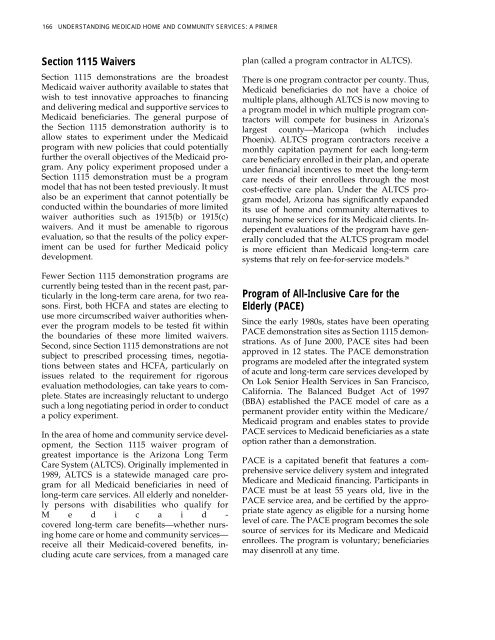Full PDF Version - ASPE - U.S. Department of Health and Human ...
Full PDF Version - ASPE - U.S. Department of Health and Human ...
Full PDF Version - ASPE - U.S. Department of Health and Human ...
- No tags were found...
You also want an ePaper? Increase the reach of your titles
YUMPU automatically turns print PDFs into web optimized ePapers that Google loves.
166 UNDERSTANDING MEDICAID HOME AND COMMUNITY SERVICES: A PRIMERSection 1115 WaiversSection 1115 demonstrations are the broadestMedicaid waiver authority available to states thatwish to test innovative approaches to financing<strong>and</strong> delivering medical <strong>and</strong> supportive services toMedicaid beneficiaries. The general purpose <strong>of</strong>the Section 1115 demonstration authority is toallow states to experiment under the Medicaidprogram with new policies that could potentiallyfurther the overall objectives <strong>of</strong> the Medicaid program.Any policy experiment proposed under aSection 1115 demonstration must be a programmodel that has not been tested previously. It mustalso be an experiment that cannot potentially beconducted within the boundaries <strong>of</strong> more limitedwaiver authorities such as 1915(b) or 1915(c)waivers. And it must be amenable to rigorousevaluation, so that the results <strong>of</strong> the policy experimentcan be used for further Medicaid policydevelopment.Fewer Section 1115 demonstration programs arecurrently being tested than in the recent past, particularlyin the long-term care arena, for two reasons.First, both HCFA <strong>and</strong> states are electing touse more circumscribed waiver authorities wheneverthe program models to be tested fit withinthe boundaries <strong>of</strong> these more limited waivers.Second, since Section 1115 demonstrations are notsubject to prescribed processing times, negotiationsbetween states <strong>and</strong> HCFA, particularly onissues related to the requirement for rigorousevaluation methodologies, can take years to complete.States are increasingly reluctant to undergosuch a long negotiating period in order to conducta policy experiment.In the area <strong>of</strong> home <strong>and</strong> community service development,the Section 1115 waiver program <strong>of</strong>greatest importance is the Arizona Long TermCare System (ALTCS). Originally implemented in1989, ALTCS is a statewide managed care programfor all Medicaid beneficiaries in need <strong>of</strong>long-term care services. All elderly <strong>and</strong> nonelderlypersons with disabilities who qualify forM e d i c a i d -covered long-term care benefits—whether nursinghome care or home <strong>and</strong> community services—receive all their Medicaid-covered benefits, includingacute care services, from a managed careplan (called a program contractor in ALTCS).There is one program contractor per county. Thus,Medicaid beneficiaries do not have a choice <strong>of</strong>multiple plans, although ALTCS is now moving toa program model in which multiple program contractorswill compete for business in Arizona'slargest county—Maricopa (which includesPhoenix). ALTCS program contractors receive amonthly capitation payment for each long-termcare beneficiary enrolled in their plan, <strong>and</strong> operateunder financial incentives to meet the long-termcare needs <strong>of</strong> their enrollees through the mostcost-effective care plan. Under the ALTCS programmodel, Arizona has significantly exp<strong>and</strong>edits use <strong>of</strong> home <strong>and</strong> community alternatives tonursing home services for its Medicaid clients. Independentevaluations <strong>of</strong> the program have generallyconcluded that the ALTCS program modelis more efficient than Medicaid long-term caresystems that rely on fee-for-service models. 26Program <strong>of</strong> All-Inclusive Care for theElderly (PACE)Since the early 1980s, states have been operatingPACE demonstration sites as Section 1115 demonstrations.As <strong>of</strong> June 2000, PACE sites had beenapproved in 12 states. The PACE demonstrationprograms are modeled after the integrated system<strong>of</strong> acute <strong>and</strong> long-term care services developed byOn Lok Senior <strong>Health</strong> Services in San Francisco,California. The Balanced Budget Act <strong>of</strong> 1997(BBA) established the PACE model <strong>of</strong> care as apermanent provider entity within the Medicare/Medicaid program <strong>and</strong> enables states to providePACE services to Medicaid beneficiaries as a stateoption rather than a demonstration.PACE is a capitated benefit that features a comprehensiveservice delivery system <strong>and</strong> integratedMedicare <strong>and</strong> Medicaid financing. Participants inPACE must be at least 55 years old, live in thePACE service area, <strong>and</strong> be certified by the appropriatestate agency as eligible for a nursing homelevel <strong>of</strong> care. The PACE program becomes the solesource <strong>of</strong> services for its Medicare <strong>and</strong> Medicaidenrollees. The program is voluntary; beneficiariesmay disenroll at any time.
















